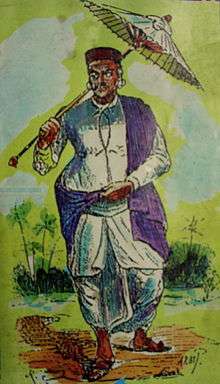Shett
Shett (also spelt as Shet) (Konkani: शेट, Kannada: ಶೆಟ್ಟ) is a name given to the Daivajnas of Konkani origin residing on the west coast of India. It is also an honorific title and a common surname used by them in Coastal Karnataka.[1]

Etymology
The word Shet is derived from the Sanskrit word Śreṣṭha (Devanagari: श्रेष्ठ) or Śreṣṭhin (Devanagari: श्रेष्ठीन्) meaning superior, Prakritised as Seṭhī (Devanagari: सेठी), and then Śeṭ (Devanagari: शेट) or Śeṭī (Devanagari: शेट) in modern Indo-Aryan dialects.[2]
The guilds of the traders, merchants and their employees in ancient Goa, like other parts in India, were called as Śreṇī, and the head of these guilds were called as Śreṣṭha or Śreṣṭhīn, which would mean His Excellency.[3]
Usage
Various Romanised versions found during the colonial period include Chatim, Xete, Xetim, Xatim, Chati, Sette etc.[4][5] Alternatively it is also spelled as Shet, Sait, Shetty nowadays.
Before the Goa Inquisition, Daivajna men used the titles Sethi etc. after their first names. e.g. Virupa Chattim, Gana Sethi etc. Father's name was used as a middle name. Daivajna diaspora started using village names after their first names to distinguish themselves from other communities. Daivajna people still in Goa still use to continue it as an honorific title. Due to various socio-economic reasons Daivajna people migrated from Goa to other places. Some started using Shet as their surname just to distinguish themselves from others (especially in South Canara, Udupi, Shimoga and in some parts of North Canara.[1]
Few Daivajna families who converted to Catholicism migrated to Mangalore due to attacks by the Marathas in Goa during the late 17th and early 18th century.[6][7] These families still use the title Śeṭ.[8] The Saldanha-Shet family is one of the well known Konkani Catholic families from Mangalore.[9]
Historical references
- The earliest reference to the word Shreshthi, in Goa are found in a copper-plate inscription, dating early 4th century mentioning certain Aditya Shreshthi of Shiroda, Goa who was a head of a guild, which was issued by the Bhoja king,Kapalivarman.[10]
- Southern Shilahara copper-plates mention Durga shreshthi, Babbhana shresthi as their ministers.
- Names of many traders like Naga Sette,Gomo Sette,Bhaira Sette have been found in a copperplate dating back to 1348 AD.[11]
- Kasarpal copperplate dating 1436 AD mentionis Rupa Sheti and his son Lakshmana Sheti, whom a certain Brahmin Nagavdeva donated the village of Varandem (which includes Kasarpal).[12]
- Gana Sethi or Gana Chatim (as his name appears in the old Portuguese documents) was an interpreter in Portugal's royal court.[13]
- Ravala Sethi or Roulu Chatim,a certain merchant of Caraim (name mentioned in 15th-century documents)[14]
- Virupa Sethi in 16th century who protested against the Portuguese.[15]
See also
References
- 1 2 Karnataka (India) (1985). Karnataka State gazetteer, Volume 16. Karnataka: Printed by the Director of Print, Stationery and Publications at the Govt. Press. pp. Page 254.
- ↑ "Gomantak Prakruti ani Sanskruti, Part-1, Page-221 by B.D. Satoskar, Shubhada Publication
- ↑ Census of India, 1961. v. 11, pt. 6, no. 14. India. Office of the Registrar General. 1962. p. 14.
- ↑ Pearson, Michael Naylor (1981). Coastal western India: studies from the Portuguese records Issue 2 of XCHR studies series. Concept Publishing Company. pp. 149 pages(see:102,126,127). ISBN 9788170221609.
- ↑ Shirodkar, Prakashchandra P. (1998). Researches in Indo-Portuguese history, Volume 1. Publication Scheme. pp. Page 194. ISBN 9788186782156.
- ↑ Christianity in Mangalore, Diocese of Mangalore, archived from the original on 22 June 2008, retrieved 30 July 2008
- ↑ Pinto 1999, p. 124
- ↑ Pinto, Pius Fidelis (1999), History of Christians in coastal Karnataka, 1500–1763 A.D., Mangalore: Samanvaya Prakashan, p. 168
- ↑ Farias, Kranti (1999), The Christian impact in South Kanara, Church History Association of India, p. 279
- ↑ De Souza, Teotonio R. De Souza (1990). Goa Through the Ages, Volume 2. Concept Publishing Company. p. 119. ISBN 9788170222590.
- ↑ Pereira, Rui Gomes (1978). Goa (in English and Portuguese). p. 179.
- ↑ Gomes Pereira, Pereira (1978). Hindu temples and deities(tranlslated from the original in Portuguese by Antonio Victor Couto). Panaji: Perera. pp. 121–122.
- ↑ "Gomantak Prakruti ani Sanskruti" by B.D. Satoskar, published by Shubhada Publication
- ↑ "The Portuguese empire, 1415-1808" By A. J. R. Russell-Wood, Page 105
- ↑ Xavier, Ângela Barreto (September 2007), Disquiet on the island: Conversion, conflicts and conformity in sixteenth-century Goa, Indian Economic & Social History Review, vol. 44, pp. 269–295